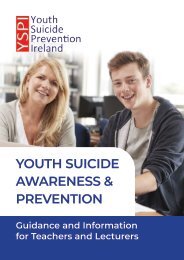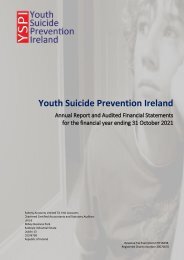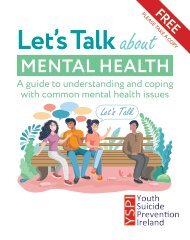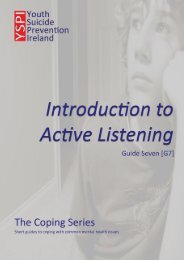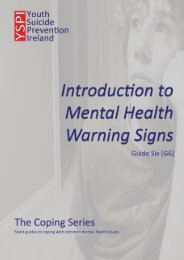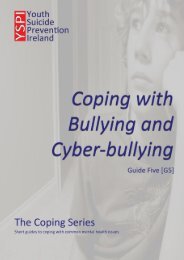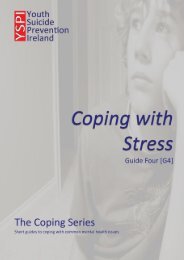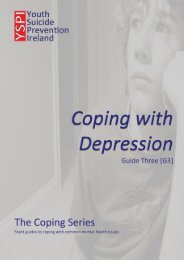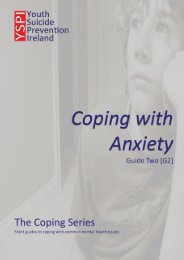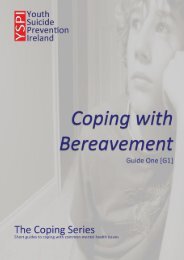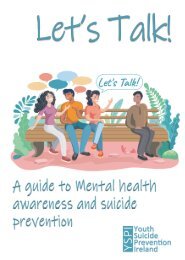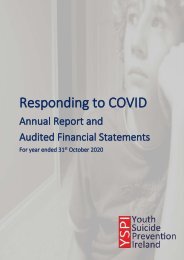What are they thinking? - YSPI Parents Handbook
A Parents Handbook to youth mental health and suicide prevention, now in it's 10th edition. Topics covered include: * Introduction to youth mental health awareness * Awareness of mental health risk factors * Recognising the symptoms of mental health issues * Helping someone with mental health issues * Understanding the dangers: Cyber-bullying Online Dangers Locked-away Syndrome * Supporting and developing coping strategies * Warnings signs of suicidal thoughts * Suicide Prevention and intervention * How to help and get help
A Parents Handbook to youth mental health and suicide prevention, now in it's 10th edition.
Topics covered include:
* Introduction to youth mental health awareness
* Awareness of mental health risk factors
* Recognising the symptoms of mental health issues
* Helping someone with mental health issues
* Understanding the dangers:
Cyber-bullying
Online Dangers
Locked-away Syndrome
* Supporting and developing coping strategies
* Warnings signs of suicidal thoughts
* Suicide Prevention and intervention
* How to help and get help
You also want an ePaper? Increase the reach of your titles
YUMPU automatically turns print PDFs into web optimized ePapers that Google loves.
<strong>What</strong> should I be watching for?<br />
P<strong>are</strong>nts <strong>are</strong> in the unique position to observe teens individually or in<br />
groups, to sense the emotions seething under the surface, and to monitor<br />
subtle changes in behaviour, and to realise that the teen in reality might<br />
be a hurting human being.<br />
It is possible for p<strong>are</strong>nts, through no fault of their own, to misinterpret a warning<br />
sign of suicide or to not even be aw<strong>are</strong> of it. This can be said of the most<br />
caring of persons. We were not born with intuitive knowledge. Along with<br />
everyone else, we must be trained to discern the messages and signals that<br />
our teens <strong>are</strong> sending out.<br />
Someone might ask, “Won’t I appear foolish if I misread the signal and get<br />
involved in a non-suicidal situation?” That is possible; but if we need to appear<br />
foolish to possibly save a life, then it is better than to suffer self-recrimination<br />
for doing nothing. The risk of a teen dying is more serious than the possible<br />
risk of being embarrassed for asking the “wrong” question. If a p<strong>are</strong>nt does<br />
raise the question of suicide needlessly, the only reaction possible is a positive<br />
one - “This p<strong>are</strong>nt c<strong>are</strong>s.”<br />
The lesson that follows is designed to help p<strong>are</strong>nts as well as teens become<br />
aw<strong>are</strong> of the hidden messages that <strong>are</strong> silently coming our way from someone<br />
in crisis who may well be planning on ending his or her life.<br />
Some of the underlying causes of youth suicide and self-harm<br />
Much work has been done to try to clarify the reasons why young people kill themselves. We know that young<br />
people who <strong>are</strong> depressed <strong>are</strong> more likely to go on to complete suicide, but it is important to state that it is still<br />
only a relatively small percentage. It is also the case that drug and alcohol misuse is certainly more common in those<br />
who die by suicide.<br />
Drugs and alcohol tend to have a two-fold effect. The first is that <strong>they</strong>, in time, act as a depressant, making low mood<br />
more likely. The second is that <strong>they</strong> tend to decrease inhibitions, and therefore remove the internal controls whereby<br />
one prevents oneself from engaging in self-harm or suicide. It is also important to be aw<strong>are</strong> that drug and alcohol<br />
misuse can be a marker, in any young person, for increasing levels of unhappiness or distress. It is not unusual for<br />
those who <strong>are</strong> unhappy to turn to drugs or alcohol to give themselves a lift, but, as has been mentioned, the effect is<br />
short lived and is replaced by a further deterioration in mood.<br />
When young people self-harm, <strong>they</strong> give a variety of reasons, but certain<br />
themes quickly emerge. The most common of these is the break-up of a relationship,<br />
or other peer difficulties.<br />
Another common situation is difficulties at home within the family, and such<br />
difficulties can either be of longstanding duration or acute. Less frequently<br />
young people describe a build-up of pressure, either academic or otherwise,<br />
which generally leads to mounting levels of tension and stress and a feeling<br />
that a young person cannot cope. If this happens in the context of a personality<br />
which is somewhat perfectionistic and rigid in nature, where a young<br />
person does not allow themselves the option of “failure”, the result can be<br />
catastrophic because a young person’s problem-solving competence in<br />
such situations becomes significantly impaired, as does their list of possible<br />
remedies.<br />
This issue of problem-solving difficulties is a recurrent one in young people<br />
because in many cases of self-harm a young person’s ability to generate an<br />
alternative solution is defective. This happens for a variety of reasons.<br />
12




